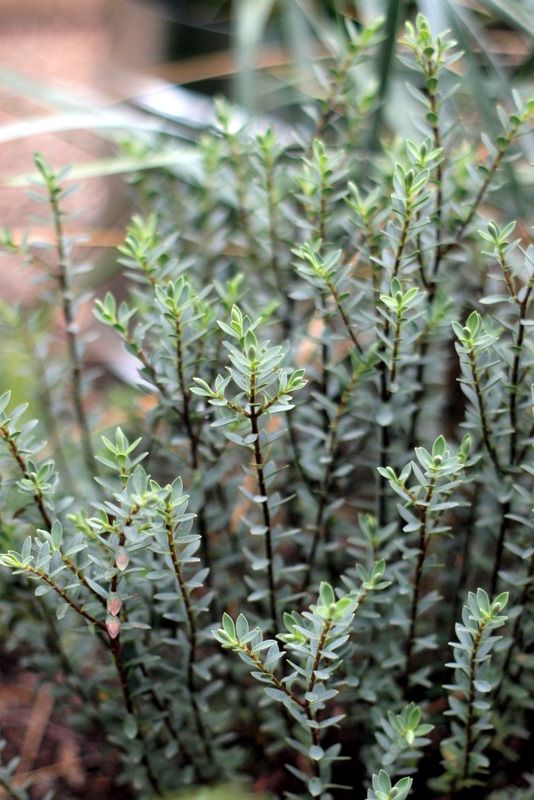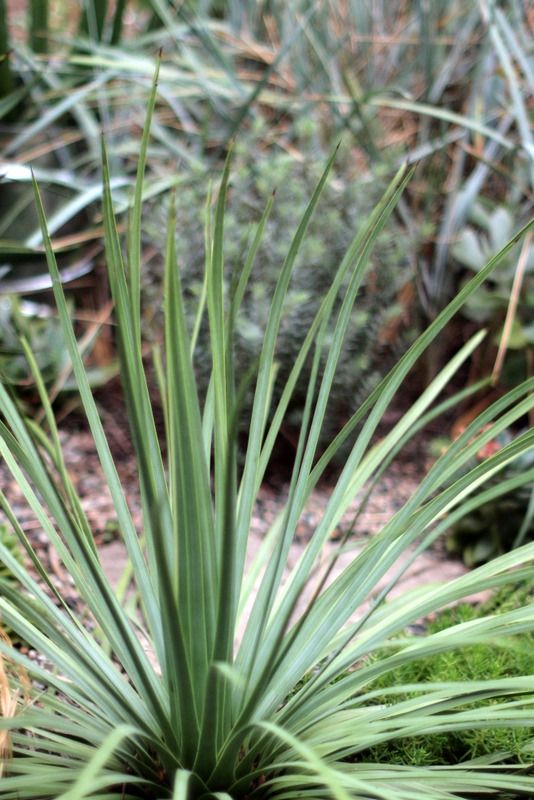Hebes are the kind of tidy plants so perfectly composed they can be accused of conveying a touch of smugness, of rendering a garden a little too safe and suburban. I take the personal position that it’s best to resist such beautiful compositions in leaf and stem or, before you know it, the garden has become an intricately quilted coverlet, a soothing, soporific place. (Like a dwarf conifer garden. Or that period in Southern California about 15-20 years ago when the landscape was snoozing in a torpor of dwarf pittosporum. You couldn’t turn a corner without bumping into a bun of dwarf pitt. And now they’ve all vanished, no doubt to be rediscovered in 10 years.) When available at nurseries, I play a recurring game of pausing to consider Hebe pinguifolia, its celadon green intricacies, always congratulating myself for giving it another pass. Passing up beautiful plants can feel ennobling, like Galadriel passing her test. Hebe ‘Pagei’ always gets a long look too. Just see what it can do with stone here.
Still I mostly resist these New Zealanders. Their culture can be tricky even when not pushing zones to grow them. They don’t like winter cold, which my zone 10 rarely gets, and my alkaline soil is favorable, but they can be touchy and brown out in patches. But I just had to grow Hebe ‘Western Hills,’ named after the former nursery and garden where it was discovered. Aside from the pedigree its name confers and sentimental associations, there’s not a drop of smugness to it. Open and airy, branching from the base to about a foot in height and half that in width its first year planted from a 4-inch, with a potential size to 3 X 3 feet, and sailing through some tough conditions in the gravel garden this summer.

Surrounded by the spikes of agaves, yuccas, dasylirion and grasses, the little shrublet is holding its own, seen through these spears.

The flowers will be pale lavender bordering on white. I’m not that interested in the flowers.
If I wasn’t thoroughly disenchanted with keeping more containers watered, this winter I’d start a little container garden of hebes and splash the pots with yogurt to get them all lichen-encrusted. Coastal conditions are preferable but probably not essential. Hardiness ranges from zone 7 to 9.
From Oregon State University, Dept. of Horticulture, which conducted hebe trials between the years 2000 and 2009:
“In New Zealand, Hebe species can be found growing in a wide range of habitats, from sea level to alpine regions, so it is no surprise that cold hardiness of the species, and the cultivars derived from them, varies widely as well. There is truth to the old saying that hardiness of Hebe is related to leaf size. As one goes up in elevation from sea level to alpine areas in New Zealand, the leaf size of the Hebes tends to decrease, and overall plant size decreases as well…So, generally speaking, you could say that the larger the leaf of the Hebe, the less cold hardy it tends to be. As with all living things, the rule is not perfect, but the most tender Hebes are usually the largest-leaved, and the hardiest are those with the smallest leaves.”

I we’ve just had a foot of snow and a week of cold weather with the lowest day being 11degrees F.
If the Hebe survives the winter, I’d like to prune it. I thought I’d clip the ends of each branch, maintaining the round shape but reducing its diameter to maintain a good fit in the space. Is this a proper way to prune this hebe? I have 3 of them in a row perpendicular to the street in the hell strip, behind 3 lavender of similar shape and size.
Thanks
Connie, that sounds like a good plan. If there’s a lot of snow damage you might need to cut back harder. Hope it works out. What a winter this year!